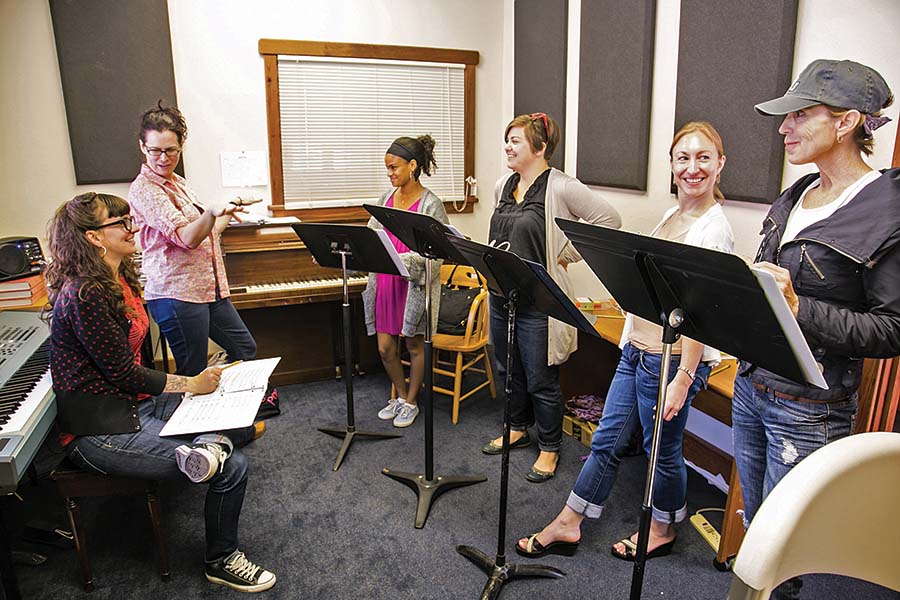What’s the goal here?
That question lies at the center of all mission-driven work, and that seemingly simple inquiry also provides the bedrock for the most widely recommended strategies for getting the most out of a staged reading. It sounds straightforward enough—to keep in mind the aims of the reading and let the rest flow from that focus. But how do you put that seemingly simple goal into practice most effectively?
Be clear up front. The consensus among the people I spoke with for this piece was clear: From the beginning, be up front about your intentions and expectations. Whether the aim is to prepare a play for production or give the writer an opportunity to hear a script out loud for the first time, or anything in between, all parties should be on the same page.
“Taking a close look at what the objective is should be primary—serving too many obligations muddies the waters,” says Michele Volansky, associate artistic director of new-play incubator PlayPenn in Philadelphia and chair of theatre and dance at Washington College in Maryland. “Understanding why it’s happening helps lead what the shape will be and who is the primary articulator of what that shape will be,” adds Daniella Topol, artistic director of Rattlestick Playwrights Theater in New York City. Madeleine Oldham, Berkeley Repertory Theatre’s resident dramaturg and director of its new-work development center, the Ground Floor, agrees. “If the reading’s focus will be on the playwright, then there should be constant communication about the needs of the piece that can change from day to day. If it’s about the audience, or a combination of artist and audience, let’s be up front about the limitations of our structures.”
Suit the action to the word. The goal established, the process can be tailored to it. With a new work, the playwright will be “front and center in articulating the agenda,” Topol says. Does the piece require scenic elements? Should there be a talkback—and if so what’s the goal of that conversation and who should lead it? Possibly more than anything else, giving the writer the time and space to do the work is crucial. The venue shouldn’t be too big or too small for the given piece, and there should be time built in for the playwright to reflect and revise, Volansky notes. “Ask a playwright what time of day rewrites happen,” adds Jeremy B. Cohen, producing artistic director of the Playwrights’ Center in Minneapolis. “If the schedule doesn’t matter to the theatre, make sure it doesn’t conflict with when the writer writes.”
Get the right people. Who participates and who attends a reading will differ according to its aim. Sometimes industry professionals will be welcome, sometimes not. Sometimes the writer will work with past collaborators, such as a dramaturg, director, or designer; with semi-staged readings, PWC employs “design dramaturgs” to give feedback. Sometimes professional actors will be involved, sometimes writers and directors will serve as readers for each other’s work.
Performer and playwright Heidi Armbruster is happy to host readings at her apartment, roasting a chicken and opening some bottles of wine while guests “read off their laptops or phones.” But when an institution backs a reading, she says, as many of the practical responsibilities as possible should be taken off the writer’s hands—making copies, for instance. A stage manager might be employed to oversee logistics. Also, hiring actors who can make clear choices quickly while carefully honoring the intent of the work, and are compensated in some way (even if just with “a hearty and fulsome thank you,” says Armbruster), as well as a good stage-directions reader, is also key. The latter role, Armbruster says, “requires an intuitive enough theatre thinker to determine what should be read and what should remain unsaid, someone who can feel pace and tempo and keep the reading on track.”
In some cases, providing “brain food” to attendees creates a friendly atmosphere and makes it more likely people will engage thoughtfully with the new work. An array of spreads, breads, and toasters called the Toast Bar greets patrons of the Play Lab series at Baltimore’s Center Stage, an idea Berkeley Rep’s Oldham brought with her to the Ground Floor from her time at Center Stage.
It’s also important to make clear to attendees what their role is, both as an audience and, if it’s included, as post-reading conversants. Above all else, Armbruster stresses, “It’s valuable to remember that at a reading all of the collaborators are there at the service of the writer—and to take your cue from the writer or director and what their needs are for the next phase in the play’s development.”


